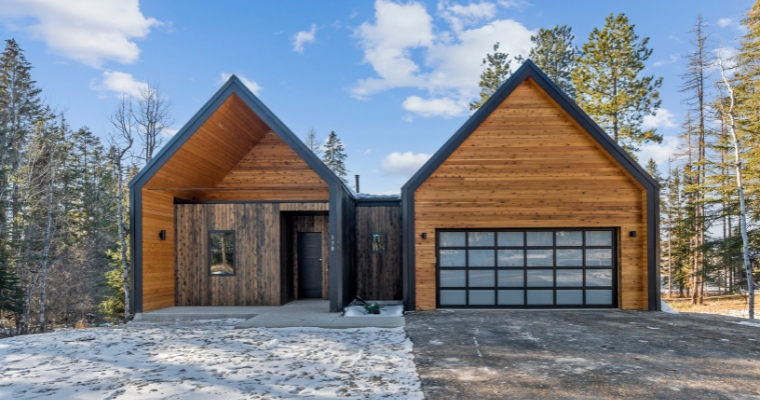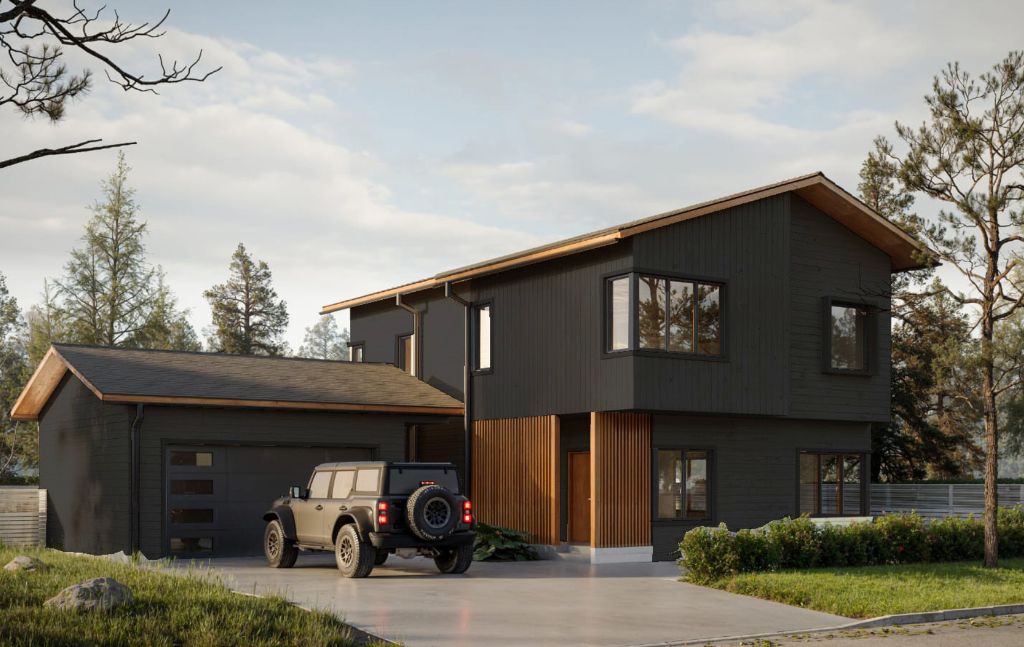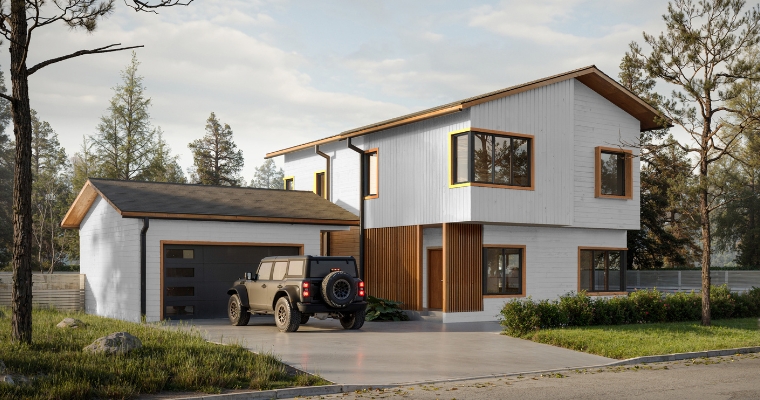How Long Does It Take to Build a Custom Home in Whitefish?
Custom homes are gaining popularity, especially in picturesque destinations like Whitefish, Montana. But one of the first questions clients ask is: How long does it take to build a custom home in Whitefish? Because timing is everything when it comes to building right.
Most custom home projects span 12 to 24 months, from the first sketch to move-in. That said, every project is unique. Usually, the house’s size, design, and some external factors will determine your house building timeline.
This guide will give you a realistic view of how long to build custom home. We’ll break down each phase of the construction process, show you where delays often happen. We will also share smart strategies to keep your project on track.
Custom‑Home Timeline at a Glance
So, how long does it take to build a custom home in Whitefish?
Building a custom home typically takes 12 to 24 months, from design to final walkthrough. That includes 6–12 months for design and permitting, and 12–24 months for the construction process. But new house construction timelines vary widely—why?
Unlike production or spec homes, custom builds start from scratch. Every decision is unique, which means more planning, approvals, and coordination. Working with trusted custom home builders in Whitefish can help streamline these decisions and reduce delays.
Here’s a quick comparison:
- Custom homes are fully personalized but take the longest.
- Production homes use pre-set plans and lots, speeding things up to around 6–12 months.
- Spec homes are move-in ready or near completion. They offer the fastest path but with limited personalization.
FEATURED LISTING
EXCLUSIVE WHITEFISH LISTING – 824 E 10TH STREET
Discover the exceptional features and prime location of this stunning home. With unique design and a rare investment opportunity, this is your chance to make it yours. Get full details today.
Phase 1 – Pre‑Construction (6–12 Months)
How long does it take to build a home in Whiefish?
Setting a fixed timeline is difficult because the pre-construction phase can largely affect the timeframe. Typically, this phase spans 6 to 12 months, and several critical steps set the trajectory for the entire project.
1. Land Search & Feasibility (1–2 Months)
Selecting the right plot is paramount. Factors such as topography, soil quality, and access to utilities play a significant role in determining the feasibility of construction.
2. Budgeting & Financing (1–2 Months)
Establishing a realistic budget is crucial.
This involves accounting for land acquisition, design fees, construction costs, permits, and contingencies. Securing financing ensures there are funds whenever needed during the process of building a custom home.
3. Architectural Programming (2 Weeks)
This pre construction step involves defining the homeowner’s needs, preferences, and lifestyle requirements. Collaborating with architects to outline room functions and design aspirations lays the groundwork for subsequent design phases.
4. Schematic Design (4–6 Weeks)
Architects develop preliminary designs based on the programming insights, including floor plans and elevations. This phase emphasizes spatial relationships, scale, and basic design concepts. It allows for initial feedback and revisions.
5. Design Development & Preliminary Pricing (4–8 Weeks)
This stage builds upon the schematic design to refine architectural details, materials, and systems. Simultaneously, the team generated the preliminary cost to align the design with the established budget.
6. Working Drawings & Engineering (4–8 Weeks)
Detailed construction documents will be created, containing structural, mechanical, electrical, and plumbing plans. These comprehensive drawings are essential for obtaining accurate bids and ensuring code compliance.
7. Permitting & HOA Approval (8–12 Weeks)
Securing necessary permits from local authorities and approvals from homeowners’ associations is a non-negotiable step. The duration can vary based on jurisdictional requirements and the project’s complexity.
Pro Tips to Shorten This Stage:
- Early Engagement: Involve key stakeholders from the outset to foster collaboration and anticipate potential challenges.
- Thorough Documentation: Create comprehensive and accurate drawings and specifications. Doing so reduces the likelihood of revisions and delays during permitting.
- Regular Communication: Maintain open lines of communication with all parties to ensure alignment and swift resolution of issues.

Phase 2 – Construction (12–16 Months)
After pre-construction, the next phase in the custom home building process is construction. This 12-16 months phase is the final step that helps answer how long does it take to build a custom home in WhiteFish. Below is the step-by-step process:
1. Site Prep & Foundation (1–2 Months)
After obtaining permits, the custom home builder clears the lot, levels the land, and installs temporary utilities. The next steps include excavation, footings, and laying the foundation.
2. Framing & Dry-In (2–3 Months)
Next comes the house’s skeleton. Walls, floors, and the roof are framed with precision. Once windows, doors, and roofing are installed, the structure is “dried in” protected from weather, and ready for interior systems.
3. Rough-Ins: Plumbing, Electrical, HVAC (1–2 Months)
Behind the walls, trades install piping, wiring, and ductwork. Conflicts between systems can stall progress, so this stage needs precise coordination. City inspections must be done before walls are closed up.
4. Insulation & Drywall (1 Month)
Once it passes inspections, insulation is placed and drywall hung. Insulation boosts energy efficiency and indoor comfort. Then, drywall sheets are hung, mudded, and sanded. Here, your home starts to feel like a series of real rooms.
5. Exterior Finishes (1 Month)
Siding, brick, stone, or stucco, final roofing, fascia, and exterior paint are installed. This locks in your home’s first impression and weatherproofing.
6. Interior Finishes & Millwork (2–4 Months)
The longest construction portion involves cabinetry, flooring, tiling, painting, lighting, and appliances. Custom features like built-ins, radiant flooring, or smart home technology for luxury homes may extend the timeline. But this is where a seasoned interior designer adds real value by ensuring style meets function.
7. Final Fixtures, Paint, Punch List (1–2 Months)
Lighting, plumbing fixtures, and final coats of paint complete the look. The “punch list” corrects minor errors or missing items before move-in.

Variables That Affect the Clock
Even the most organized build can encounter hiccups. Several factors can delay the house building timeline by weeks. Hence, there’s no certain answer to how long does it take to build a custom home in Whitefish. Below are factors that can affect the clock.
1. Lot Complexity
Steep slopes, trees, or rocky soil can delay excavation and foundation work by weeks. However, a geotechnical survey and site analysis can help anticipate challenges before breaking ground.
2. Design Size
The size and complexity of the home add to the time. You can scale back on excessive square footage, or ultra-custom features can save time.
3. Weather
Rain, snow, or extreme temperatures can halt site work, especially during foundation and framing. To mitigate this and build in seasonal buffers, aim for ground-breaking in spring or summer.
4. Subcontractor Availability
Skilled trades are often booked months in advance. A seasoned general contractor with strong relationships can keep the schedule moving.
5. Material Lead Times
Windows, custom cabinets, and specialty finishes often have 8–16 week wait times. Delays here can stall entire construction phases. It’s best to order these items immediately after plan approval.
6. Owner Decisions
Indecision on finishes or late approvals can trigger holdups. Freezing key selections early gives your team clear direction.
7. Change Orders
Design changes mid-construction may mean tearing out completed work or re-permitting, adding weeks or more. You should limit change orders by finalizing plans and finishes upfront.
FEATURED LISTING
EXCLUSIVE WHITEFISH LISTING – 824 E 10TH STREET
Discover the exceptional features and prime location of this stunning home. With unique design and a rare investment opportunity, this is your chance to make it yours. Get full details today.
Homeowner Playbook for Staying on Schedule
How long does it take to build a custom home in Whitefish?
As a homeowner, you can also reduce how long it takes to build your home to ensure everyone follows the custom home construction schedule. Here are proactive steps homeowners can take to keep things on track and minimize delays.
1. Freeze Core Decisions Early
Delays often arise when decisions about layouts, materials, or finishes are made late in the game. Freezing these core decisions at the start ensures the project stays aligned with the custom home construction timeline.
2. Order Long-Lead Items at Plan Approval
Items like windows, custom cabinetry, and specialty materials have long lead times. Hence, it’s best to order these well ahead of time. The best time is as soon as the plans are approved to help avoid hold-ups later.
3. Maintain Weekly Check-ins with the Builder and the Designer.
Ideally, weekly, regular check-ins let you know of progress made. These sessions also allow the custom home builder and interior designer to raise possible delays or concerns. This process helps you resolve problems before they become more serious.
4. Keep a 10% Time Contingency in Mind
Unexpected delays can affect even the best-planned constructions. Hence, adding a 10% time buffer to your project schedule helps you to account for unforeseen events. This cushion helps to keep things under control and guarantees that little setbacks won’t surprise you.

Handling Delays Strategically
Even with careful planning, delays are often inevitable during custom home construction. Understanding common setbacks and having a strategy can make all the difference.
1. Common Setbacks
Permit delays, extreme weather conditions, and supply chain problems are among the most frequent setbacks in the home building timeline. BuilderOnline states the permitting process can take several months, particularly in areas with high demand.
2. Contingency Housing Options and Budget Buffers
Having a backup for temporary housing helps to reduce anxiety during delays. Budgeting for potential delays is similarly essential. Keep 5-10% of the budget as a buffer to help protect against unforeseen costs.
3. Communication Templates for Addressing Schedule Slips
Keeping open lines of communication with your designer and builder is key.
Make a prior communication strategy with templates for handling schedule changes to guarantee all parties are in sync. This helps to reduce misunderstandings and keep the project on track.
Case Studies
To illustrate the real-world application of the custom home timeline to help you know how long does it take to build a custom home in Whitefish, let’s explore two notable Eco Residency projects: 824 E 10th Street and 158 Mountain Brook Lane.

824 E 10th Street in Whitefish
This custom home project shows how attention to detail during pre construction can greatly affect the overall timeline. Permitting and an unanticipated cold snap caused little delays for the project. However, with the proactive strategy employed by the project team, they could sustain pace and finish the build promptly.
As detailed on the our project page, early planning and open communication with subcontractors guaranteed seamless coordination despite unforeseen challenges.

158 Mountain Brook Lane, Whitefish, MT
A remarkable example of custom home luxury, this project takes full advantage of the building timeframe, strictly following deadlines. The Homeowner Playbook describes how the team’s early ordering of long-lead products like windows and cabinets allowed for uninterrupted progress. Using project management tools and an effective custom home construction schedule, this house was finished within the anticipated period.
FAQs
It typically takes 12 to 24 months to build a custom home, depending on design and unforeseen delays. Factors like material availability and weather can affect the new home construction timeline.
The realistic answer to how long does it take to build a home can vary. But for the timeline for a custom home, expect a process spanning 12 to 24 months. Planning ahead helps minimize delays.
Traditional homes may take 6 to 12 months. However, custom homes often require more time due to their tailored designs and unique specifications.
How long it takes to build a 5000 sq. ft. home differs based on custom design and specific project needs. Usually, it takes between 12 and 18 months.
FEATURED LISTING
EXCLUSIVE WHITEFISH LISTING – 824 E 10TH STREET
Discover the exceptional features and prime location of this stunning home. With unique design and a rare investment opportunity, this is your chance to make it yours. Get full details today.
Conclusion
Answering the question how long does it take to build a custom home in Whitefish depends on several factors, especially design intricacies and house size. However, wise planning and good coordination will help minimize delays. But building a custom home in Whitefish generally takes between 12 to 24 months.
Check out the Eco Residency timeline tools or book a planning call today for further ideas or assistance in planning your custom home project or investing in Whitefish properties.


Leave a Reply
Want to join the discussion?Feel free to contribute!